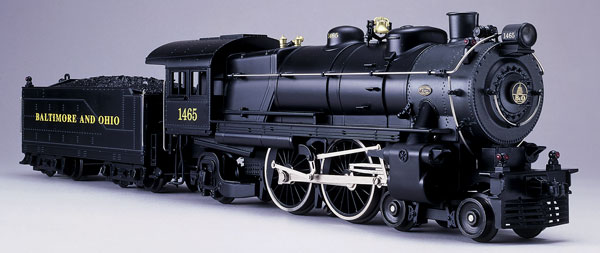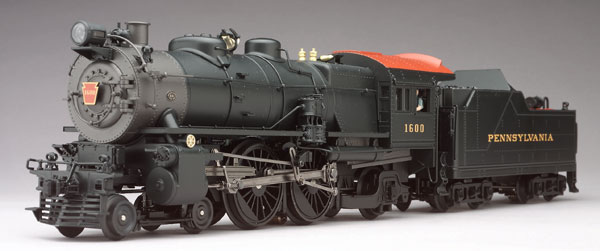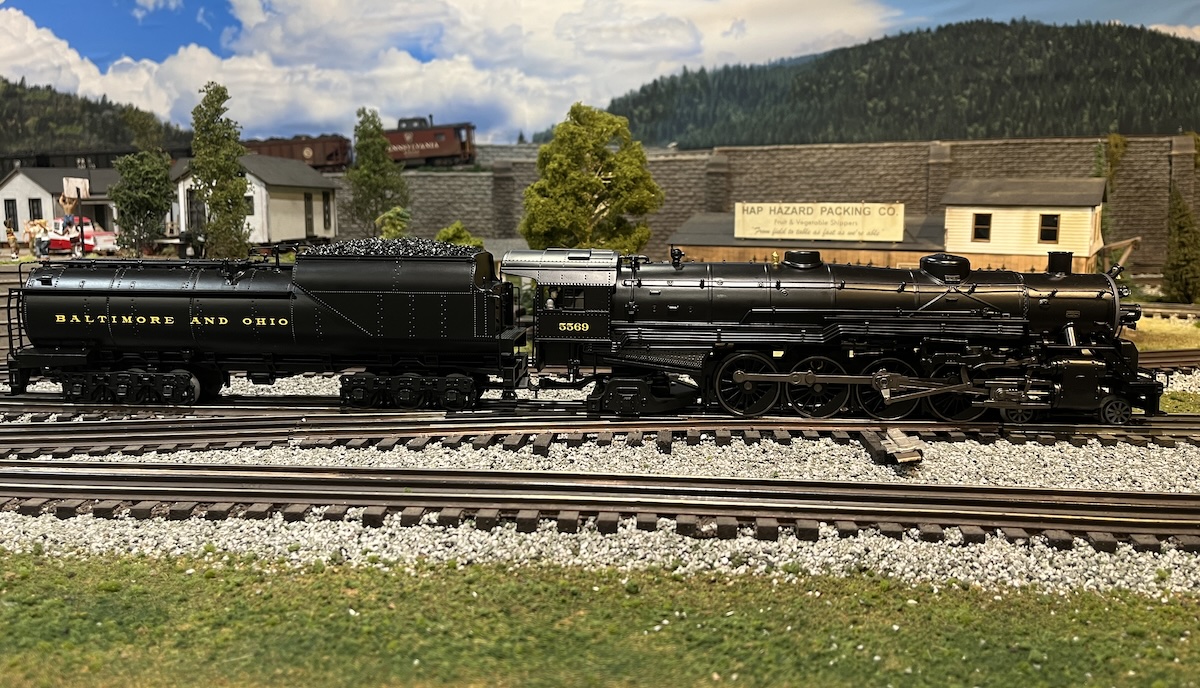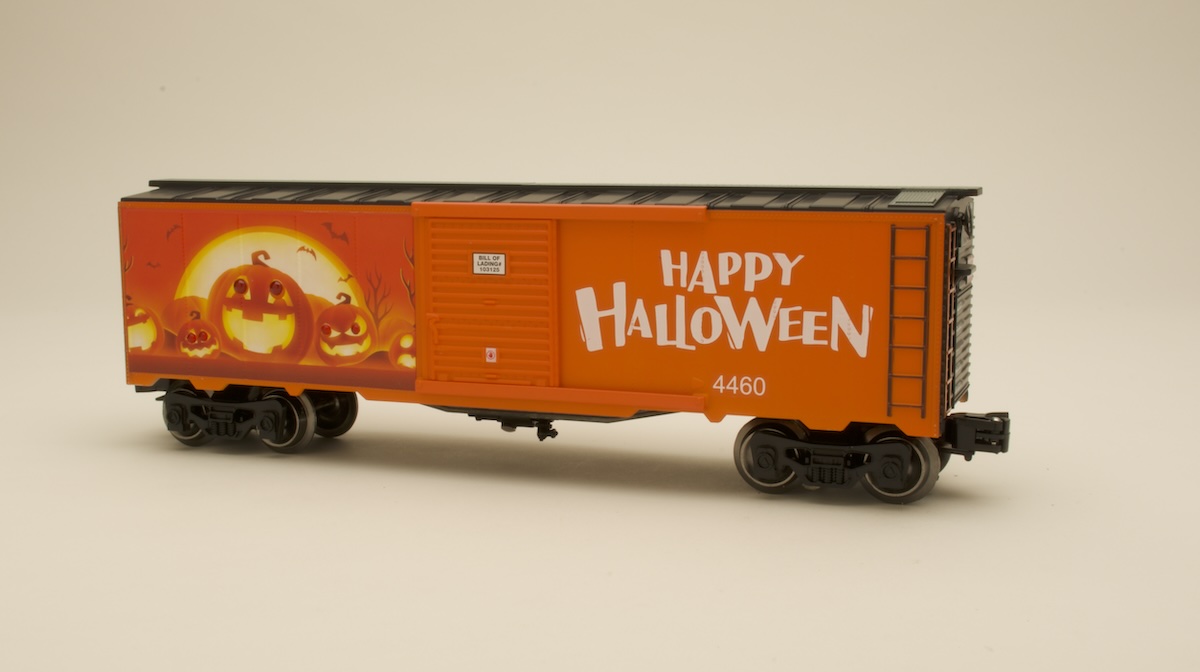The Atlantic’s 4-4-2 wheel arrangement allowed for a larger firebox and improved performance. The 4-4-2s also pulled heavier trains faster than the old 4-4-0s. The 4-4-2 wheel arrangement appealed to the staff of the Pennsylvania Railroad, and the attention they lavished on the 4-4-2 design resulted in an impressive series of E-class locomotives.
MTH’s locomotive is a model of the Pennsy E6, and Lionel offers E6s under more than one road name; I tested Lionel’s Baltimore & Ohio version. The B&O called its locomotive an A2, which is a Pennsy E3a design.
The MTH Pennsy Atlantic
Once in a blue moon I’m genuinely surprised by a new locomotive, and the MTH Premier line Atlantic is a perfect case in point. I never thought any two-axled steam power would catch my eye. They are just not my taste. But I was genuinely blown away by MTH’s E6. This steamer delivers unexpectedly robust performance, considering it has only four drivers, and it looks great! The pilot sports an attractive cowcatcher and a dummy scale coupler with a simulated uncoupler chain. There are plenty of painted wire handrails along the locomotive’s sides, over the top of the smokebox, and beneath its keystone. There are other add-on details, such as the compressor, piping, and a mondo keno reverse lever. The cab has two crew figures, a nicely appointed backhead, and “glass” in several windows.
The engine features four illuminated marker lights and illuminated number boards on either side of the headlight. It also packs a backup light and two more illuminated markers on the tender, as well as a single white bulb in the cab. There is also the now-expected red firebox glow feature.
According to Al Staufer in his book Pennsy Power (Staufer, 1962), the E6-class had two main tenders, the 70P66 and 90P66, though from time to time engines of many classes used other tenders. The Premier line Atlantic has a tender labeled as a 70P68. Although we did dig up a few photographs of Atlantics that appeared to be coupled to a 70P68 tender, this tender may look more at home behind a G5-class 4-6-0. Still, the rig has wire handrails, a ladder, and a coal load made from individual “chunks” rather than cast-in coal.
On the underside of the engine I was surprised to see only two pickup rollers – one on the locomotive and the other spaced about a foot away beneath the tender. Two is the minimum; many toy train locomotives with sound systems use four.
The locomotive’s paint job is superb. The smokebox is gray, and the bodies of the engine and tender are a silky smooth Brunswick green. The cab roof and deck of the tender are Tuscan. Of special note are the darkened side rods and drive wheels, a far more realistic look than plated metal pieces.
Including the overly long drawbar and the O gauge coupler, the locomotive measures 193/4 inches long by 33/4 inches tall (79 by 15 feet in O scale), compared to the prototype’s 68-foot, 51/2-inch length and 15-foot height.
On the test track
After briefly warming up the Atlantic, I latched it to a 25-car freight train and was surprised at how easily it got the train under way. My bias against “four wheelers” was quickly forgotten.
Of the ProtoSound 2.0-equipped steamers that I’ve heard so far this year, the Atlantic is, without a doubt, the best. Sound reproduction has a much wider range, and, when you couple the audible chuffs in sync with smoke whooshing out of the stack, you have a winning combination.
While the engine sounded good under way, it was at its best at slow speeds where you could closely watch the relationship between the movement of the rods and wheels, the bursts of fan-driven smoke shooting from the stack, and hear the chuffs, hisses, and thunks!
The MTH Atlantic also offers the usual array of station sounds and crew talk, including an action sequence that simulates a train’s boarding and departure. It also features MTH’s locomotive “cruise control.” We’re still awaiting the release of MTH’s ProtoSound 2.0 command handheld units, so the Atlantic was tested in conventional mode only.
On the test track, performance was excellent. The low-end speed average was 5.2 scale mph. The high-end average was 81.1 scale mph. Harnessed to a 25-car freight train and running at 18 volts, the engine delivered a consistent 80.8 scale mph.
The 9-pound, 31/2-ounce locomotive generated 2 pounds, 10 ounces of drawbar pull, which is equal to roughly 126 modern pieces of rolling stock.
The MTH Atlantic is a beautiful locomotive. I admit that I was indifferent to Atlantic-types before opening this box, but the MTH E6 has turned my opinion 180 degrees. – Bob Keller
Lionel’s B&O Atlantic
A Pennsy engine in B&O colors? Yup, Lionel is correct in offering this engine as Baltimore & Ohio gear.
The Baltimore & Ohio has been under the control of many masters, and at the time of the creation of the B&O A2-class Atlantic, the Pennsy controlled the carrier. According to Lawrence Sagle in B&O Power (Al Staufer, 1964), in 1903, when the B&O needed a new Atlantic, the Pennsylvania shared the plans for its E3a-class engine.
Alco built 19 of the engines, numbered 1456 to 1475. Sagle’s earlier work, A Picture History of B&O Motive Power (Simmons-Boardman Publishers, 1952), reported that the last A2 Atlantic was no. 1474, which was modernized in 1926. The engine was scrapped in 1947.
The model
Including the drawbar and oversized O gauge coupler, the engine measures 183/4 inches long by 33/4 inches tall (75 by 15 feet in O scale) compared to the prototype E6’s (the engine that is actually modeled here) measurements of 68 feet, 51/2 inches by 15 feet.
The Lionel engine features a scale coupler on the pilot, a nice cowcatcher, and four marker lights on the point. The headlight has the engine number painted on either side, but the numbers aren’t illuminated.
There are wire handrails on the smokebox, along the sides of the locomotive, and over the top of the smokebox. The lines of the real Atlantic were fairly smooth and clean, and Lionel’s model mirrors that. The cab is crewless, and the backhead has a rather basic-looking array of cast-in details. The cab isn’t illuminated, but it does have a red firebox glow, which is a nice feature.
The tender is a Pennsy 70P66 with a cast-in coal load, wire handrails, a separate ladder, and three illuminated marker lights. The trucks are good models of Dolphin trucks, which according to Fred Westing’s Apex of the Atlantics (Kalmbach, 1962), enhanced the ride of both tender and locomotive.
Looking at the undercarriage, I noted that there were two pickup rollers on the locomotive for motor power and two on the tender for the sound system. The roller brackets on the tender are made of metal and plastic, and look delicate. The rear roller on our tender wouldn’t spring back properly when pressed down and wouldn’t make proper contact with the center rail.
The painting and lettering of the B&O version, nice as they may be, don’t do the model justice, especially when placed next to the MTH Atlantic. The handrails on the B&O Atlantic are unpainted, which really stands out when compared to the Pennsy engine. And while both have the same basic body and many of the same details and reference points, the satin black finish makes the B&O version look more toy-like.
On a nit-picking level, some readers might take note that the B&O Atlantic was an E3a design made by Schenectady (later Alco) while the Lionel B&O, model bears an E6s builder’s plate from the PRR’s Juniata Shops.
On the test track
This engine dug right in and handled our 25-car freight train like a champ. Its performance was smooth in all speed ranges.
The low-speed average of the engine was measured at 15.5 scale mph, while the high-end average was 154.9 scale mph. With the 25-car train in tow at 18 volts, we clocked the engine at 111.1 scale mph.
The 6-pound, 81/2-ounce locomotive mustered 2 pounds, 4 ounces of drawbar pull, equal to 108 modern cars.
RailSounds was up to the usual, crisp standards, and the array of steam sounds, chuffs, and crew conversation helps add life to a layout.
With the Atlantic, Lionel has made an interesting model of a footnote locomotive in B&O history.















